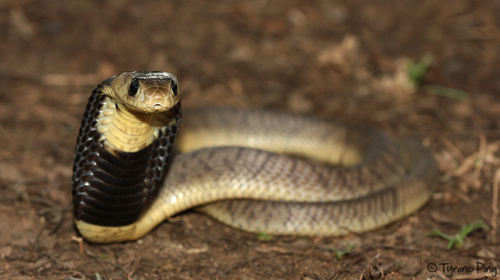
Snouted Cobra
Naja annulifera, or the banded cobra, mesmerizes with its bold stripes and notorious hood display. Inhabitants of southern Africa, these snakes play a crucial role in controlling small mammal populations, balancing ecosystems. Often seen in daylight, their presence signals a vibrant, interconnected habitat.
20 years
Lifespan
Length: 1.2192 - 2.4384 m
Size
Brown, Yellow, Blue
Color
Least Concern
Conservation Status
Stable
Population Trend
Characteristics
The banded cobra, Naja annulifera, is a venomous snake found in southern Africa. It thrives in savannas, forests, and grasslands, often near water sources. Notable for its striking banded appearance and defensive hood flare, this cobra is diurnal, preying on small mammals and birds.
Distribution Range of the Snouted Cobra
Naja annulifera, commonly known as the Snouted Cobra, is native to sub-Saharan Africa. Its geographical distribution includes countries such as South Africa, Botswana, Namibia, Zimbabwe, Mozambique, Eswatini, and parts of southern Angola. It is typically found in regions with a mix of savannah and grassland environments.
Snouted Cobra's Habitat
Environmental Conditions
The Snouted Cobra inhabits a variety of environmental conditions, primarily within savannahs, semi-deserts, and regions with mixed open woodland. The climate in these areas is generally warm, with distinct wet and dry seasons. The species is adaptable to various habitats but prefers regions that offer ample cover and opportunities for hunting.
Ecological Niche
Naja annulifera occupies a niche as both a predator and a prey species within its ecosystem. It primarily feeds on small mammals, amphibians, and other reptiles, showcasing its role as a mid-level predator. The species is known for its ability to adapt to different habitats, including human-modified landscapes, as long as sufficient prey and cover are available. Its presence helps control the population of its prey species, contributing to the ecological balance within its native regions.
Copyright @ Nature Style Limited. All Rights Reserved.
 English
English